“十四五”土壤质量与食物安全前沿趋势与发展战略*
2020-10-22徐建明刘杏梅2
徐建明刘杏梅2
“十四五”土壤质量与食物安全前沿趋势与发展战略*
徐建明1,2†,刘杏梅1,2
(1. 浙江大学环境与资源学院,杭州 310058;2. 浙江省农业资源与环境重点实验室,杭州 310058)
土壤质量与食物安全和人体健康息息相关。土壤质量与食物安全这一分支学科作为“十四五”土壤科学发展战略重要的组成部分,致力于治理与改善耕地土壤质量以应对粮食安全危机。文献计量结果表明,与发达国家相比,中国在该领域的研究起步较晚,但近年呈现加速上升甚至有超越的趋势。随着气候及环境污染问题凸显,国际上的相关研究热点集中于环境监测、土地利用、施肥管理、污染修复(重金属、抗生素、有机农药和病原微生物)及可持续发展等方面。本学科以土壤质量、土壤污染和粮食安全为重点研究方向,通过与地理信息学、环境科学、应用数学、医学等学科的交叉融合,借助同位素源解析、生物地球化学循环、分子生物学等前沿性理论与技术,未来将解决区域土壤质量监测、养分质量管理、食物安全与人体健康风险、土壤-作物系统中污染物迁移转化及阻控修复等关键科学问题。
土壤质量;食物安全;土壤污染;计量分析;未来需求
土壤质量指土壤维持生态系统生产力,保障环境质量,促进动物和人类健康的能力[1],而在土壤学背景下食物安全主要指通过系列保障措施确保生产无毒、无害的农产品,包括生产过程安全与产品安全[2]。土壤质量与食物安全这一学科旨在综合评估和改善土壤质量,保障土壤生态安全和资源可持续利用,运用规范的生产技术、方式及标准,生产对人或动物健康不产生危害或潜在危害的农业食品[3]。
本学科致力于为我国农业生产的可持续安全发展提供基础理论和技术途径,通过治理与改善耕地土壤质量来应对食物安全问题的挑战[4]。该研究过程具有周期长、工程大、多技术手段、多学科交叉、区域管理多样性等特点[5]。
学科本身涵盖了土壤生产综合指标体系、土壤生态环境功能、食物安全及健康风险[6]、地理信息技术及数学模型[7-9]、土壤污染迁移转化、农业管理及品种筛选[10]、土壤质量改良及污染修复[11]等多个分支方向。随着世界温饱问题的解决及全球一体化进程的加快,大部分国家和地区已从食物产量短缺的危机转向由产地污染引起的食物安全问题,继而使得食物的质量安全上升为人类普遍关注的焦点。考虑土壤质量与食物安全之间的关系需要从土壤质量退化、农业投入品施用、土壤环境污染风险管控、农业管理对策及措施等各个方面进行切入[12]。
本文介绍了土壤质量与食物安全学科的研究进展,从文献计量分析[13-14]的角度阐述该学科现有方向及国内外研究热点,并根据当前的需求提出该学科的关键问题、理论前沿及优先交叉研究领域,为该学科的探索和发展提供启示与未来方向。
1 学科发展现状
1.1 研究方向
土壤质量与食物安全这一学科共设置了三大研究方向。(1)土壤质量。其主要关键词包括土壤有机碳,土壤氮素管理,土壤微生物生物量,种植与耕作措施,土壤生物指标,土壤物理指标,土壤化学指标,土壤综合指标,土壤质量指数,土壤生态功能,遥感监测,土壤肥力质量,土壤环境质量,土壤健康质量,食物安全,地统计学,地理信息系统。(2)土壤污染与农产品安全。其主要关键词为产地环境,污染物吸收,污染物迁移,污染物转运,污染物转化,农产品安全,农产品品质,绿色农产品,农产品重金属积累,农产品农药残留,品种筛选,作物抗逆性,风险预警,风险评估,实验模拟,模型模拟,生物污染,抗性基因,环境医学。(3)土壤质量与粮食安全。主要关键词为农田地力,农田生产力,耕地质量,土壤退化,土壤肥力,土壤肥力减退,盐碱土改良,承载力,阈值,农业管理,种植结构,商品粮基地,粮食安全,可持续发展,全球变化,情景分析,模型模拟,需求预测。
1.2 研究热点——基于文献计量
基于Web of Science(WoS)核心合集数据库,本文通过对关键文献、研究主题、关键词的聚类分析,获得了现阶段关于土壤质量与农产品、粮食安全的研究热点,归纳总结了其变迁及未来的趋势。
1.2.1 土壤质量热点分析文献计量 近些年来,国际上对于土壤质量相关问题的关注程度越来越高[15],发文数量逐年增大(图1)。在该领域发文数量排名前5的国家是美国、中国、巴西、西班牙和印度。欧洲一些国家由于曾面临严重的土壤质量问题[12,16-17],因而对土壤质量问题的关注较早[16,18-19]。亚洲国家对于土壤质量问题的相关研究起步较晚,但是近些年来呈加速上升趋势。美国起步较早,前期开展了大量研究,后期速度放缓。值得注意的是,中国在土壤质量研究领域异军突起,近些年来的发文量逐渐超过美国,成为该领域发文量最大的国家。从发文的主要学科来看,土壤科学的发文比重最大,说明关于土壤质量问题的研究,一直是土壤科学工作者关注的重点,此外环境科学领域对于土壤质量的关注程度也占有一定的比例。

图1 土壤质量研究领域主要国家(A)与主要学科发文数量(B)逐年变化
根据土壤质量研究的关键词共现网络,关于土壤管理、土壤有机质、土壤微生物量、土壤氮素管理以及土壤质量评价指标是该领域研究的热点(图2)。随着世界气候及环境等问题的逐渐凸显[20],国际上对土壤环境监测、碳汇的研究增加[21],最近几年在生物质炭[22]方面的研究也比较多。
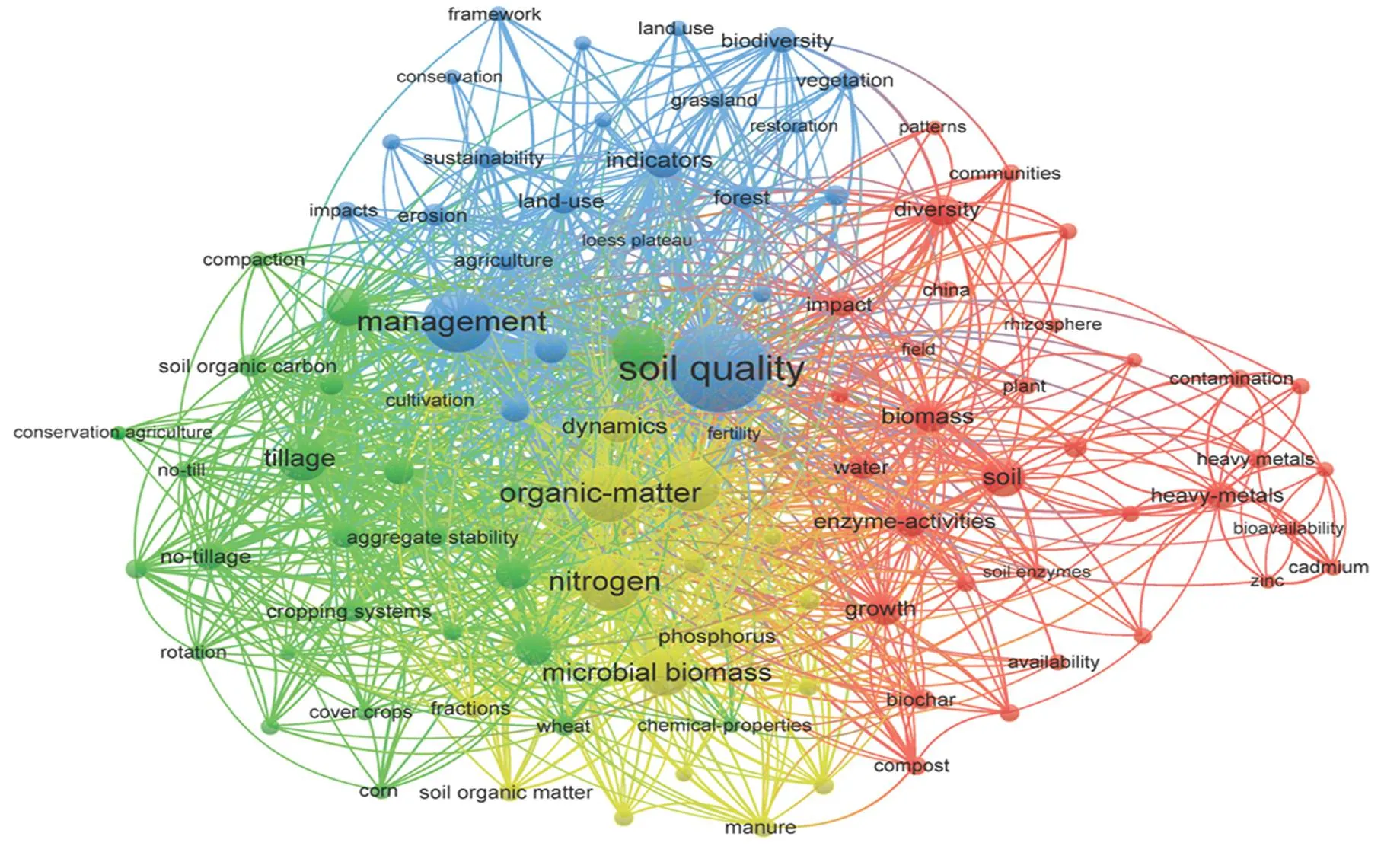
图2 土壤质量领域关键词共现网络
1.2.2 土壤污染与农产品安全热点分析文献计量
伴随人类剧烈的工业、农业生产活动,各种无机、有机污染物不断进入土壤环境[23]。根据检索结果可以发现(图3),1974年出现了第一篇土壤污染与食物安全的相关文献,2002年后历年文献数量皆高于50篇,2005年后发文量逐年上升,同时农产品安全领域越来越受研究者的关注。在发文量方面,中国、美国、巴西位居前三。在各国合作研究方面,美国与其他国家的合作交流最为广泛,其次是中国。
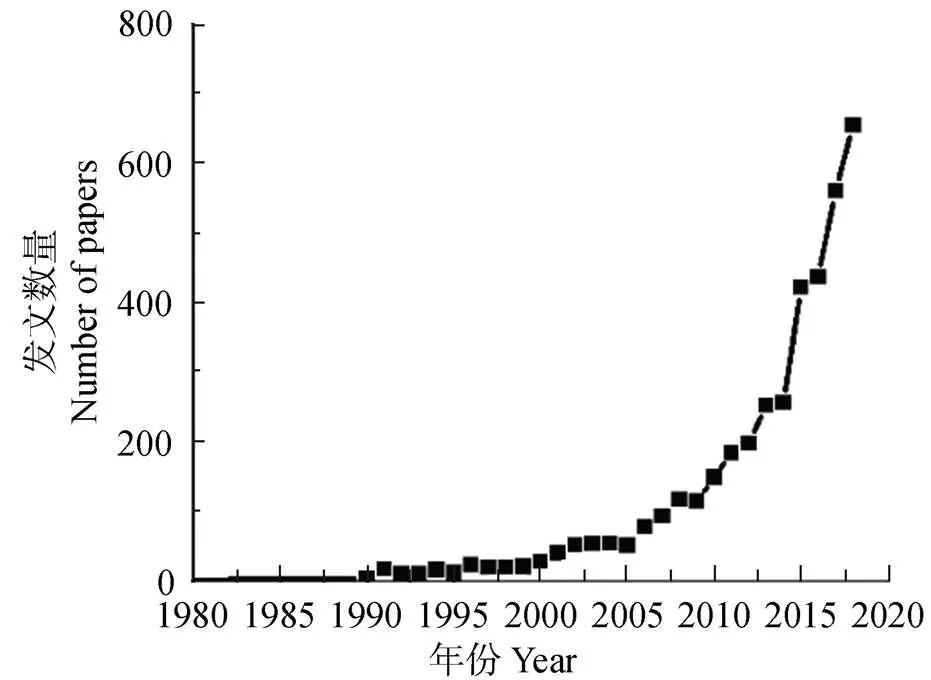
图3 土壤污染与食物安全领域的年文献产出量
根据关键词共存网络(图4),土壤污染与农产品安全领域的关键词可以主要划分为四个聚类。红色关键词聚类的研究内容主要是土壤镉、铅等重金属污染物对食物安全的影响,包括粮食作物的重金属积累、土壤污染对作物生长的影响等方面[24-25]。绿色关键词聚类的研究内容主要是病原微生物及其抗性基因对土壤生态系统多样性和功能造成的毒害作用,从而引发对农产品安全的影响,包括土传病虫害、抗生素抗性基因、抗菌素耐药性等方面[26]。蓝色关键词聚类的研究内容主要是农药残留对食物安全的影响,包括食物分析、农药快速提取检测等方面[27]。黄色关键词聚类则主要集中在与农产品安全相关的人与动物健康风险评估方面[28-29]。
1.2.3 土壤质量与粮食安全热点分析文献计量 在WoS核心合集数据库检索到1900―2019年共4 379篇文献涉及本主题,文献计量结果表明(图5),1981年开始出现第一篇关于土壤质量和粮食安全的研究文献,到1996年每年文献数量都在10篇以内;从1997年开始相关发文量有所增加,至2007年后历年文献数量皆高于50篇,且有逐年上升的趋势,说明土壤质量和粮食安全相关领域越来越受到国内外的重视。我国在土壤质量和粮食安全领域的国际合作联系密切,前三位主要合作国家是美国、英国和澳大利亚。
根据关键词共存网络(图6),土壤质量和粮食安全领域关键词可以主要划分为三个聚类。红色关键词聚类的研究内容主要是施肥、作物类型和水肥管理对粮食安全的影响[30-31]。绿色关键词聚类的研究内容主要是气候变化、农业模式对粮食安全的影响[32-33]。蓝色关键词聚类的研究内容主要与集约型农业的可持续发展相关,重点突出了生态系统服务功能、生物多样性、固碳、土地利用方式等方面[34]。
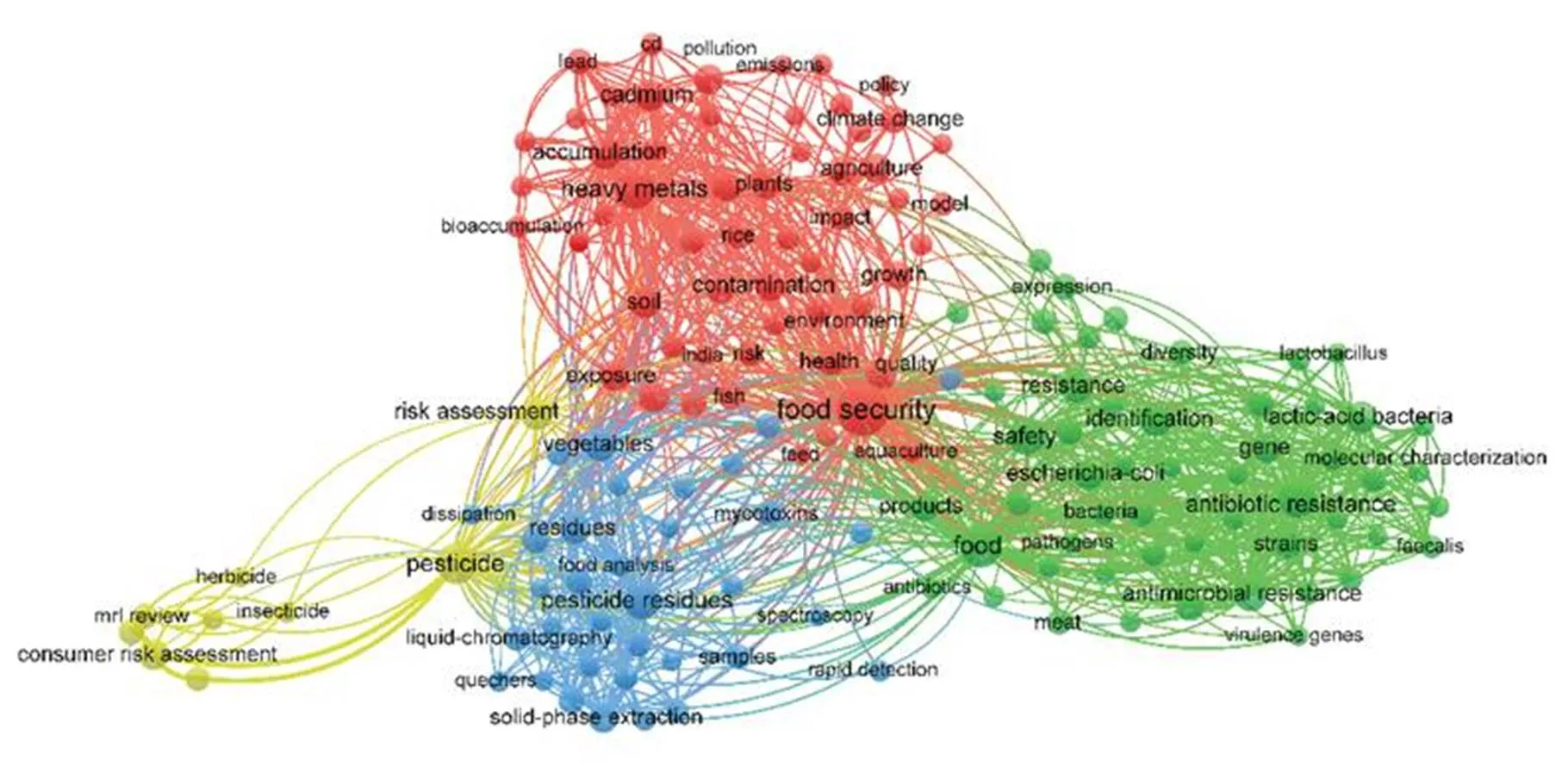
图4 土壤污染与食物安全领域关键词共现网络
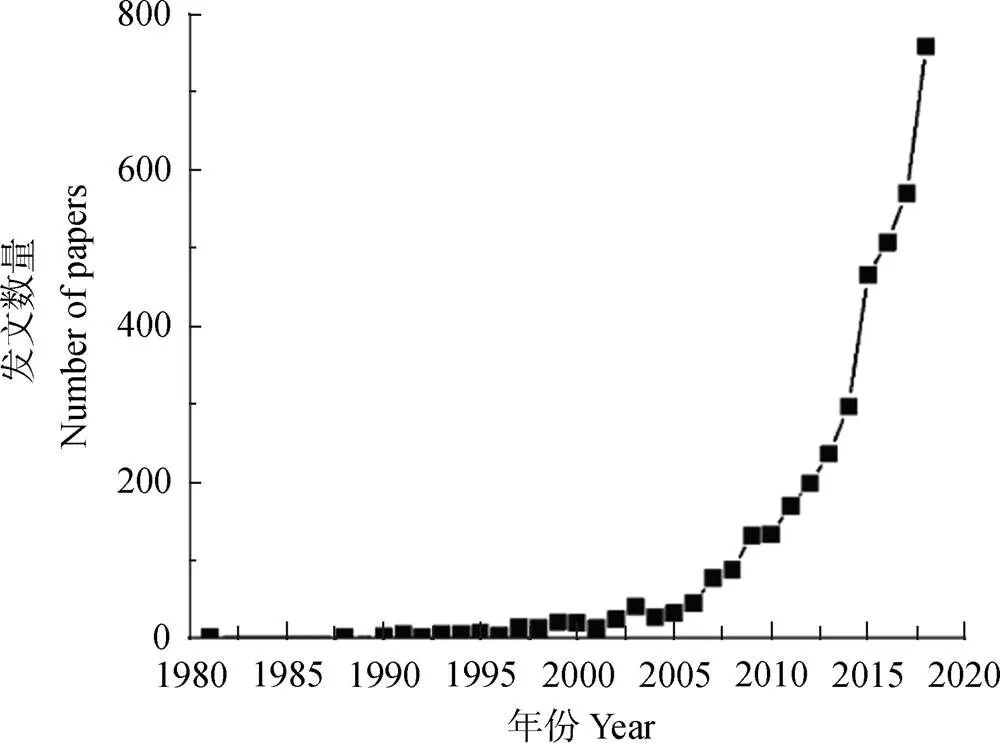
图5 土壤质量与粮食安全领域的年文献产出量
基于CiteSpace对土壤质量和食物安全领域关键词突现(Keyword Burstiness)指标进行全面分析[35],选择2014年以后的突现词来描述近五年来的研究热点(表1)。近五年来,突现强度较大关键词有区域(Region,9.645)、策略(Strategy,8.946)、缓和(Mitigation,8.636)、营养物(Nutrient,8.505)、农业集约化(Agricultural intensification,8.022)、模式(Pattern,7.686)、家畜(Livestock,7.201)、环境影响(Environmental impact,7.176)、可持续集约化(Sustainable intensification,7.157)等,可见近期土壤质量与食物安全领域的研究前沿和热点在于土壤质量区域化管理,因地制宜地制定相关策略或政策,通过土壤污染修复(包括物理、化学、生物手段)[36-38]、推行集约化模式等方法,提高土地利用率,发展可持续农业,以应对可能存在的因土地日益减少及土壤质量退化而引发的粮食安全危机[39]。
2 学科发展的关键问题与前沿趋势
2.1 关键科学问题
综合文献检索与文献计量分析,北美、欧洲在土壤质量和食物安全领域的研究起步时间较早,中国、印度等发展中国家在该方面研究起步晚,但后期发展较快,产出颇丰。此外,澳大利亚、德国、荷兰等国家也表现不凡。我国“十三五”期间首次将环境质量控制目标列为约束性指标,逐渐形成环境质量控制与污染总量控制并行的新形势,“十四五”期间将进一步巩固和提升环境质量改善成果,其中就包括土壤质量与食物安全问题,集中的关键科学问题主要有土壤质量管理与食物安全评价、区域化土壤质量与养分管理、污染物在土壤-作物系统的迁移转化规律、土壤污染阻控与修复技术、土壤生物污染防控、土壤区域污染特征与环境风险、食物安全与人体健康风险[40]。
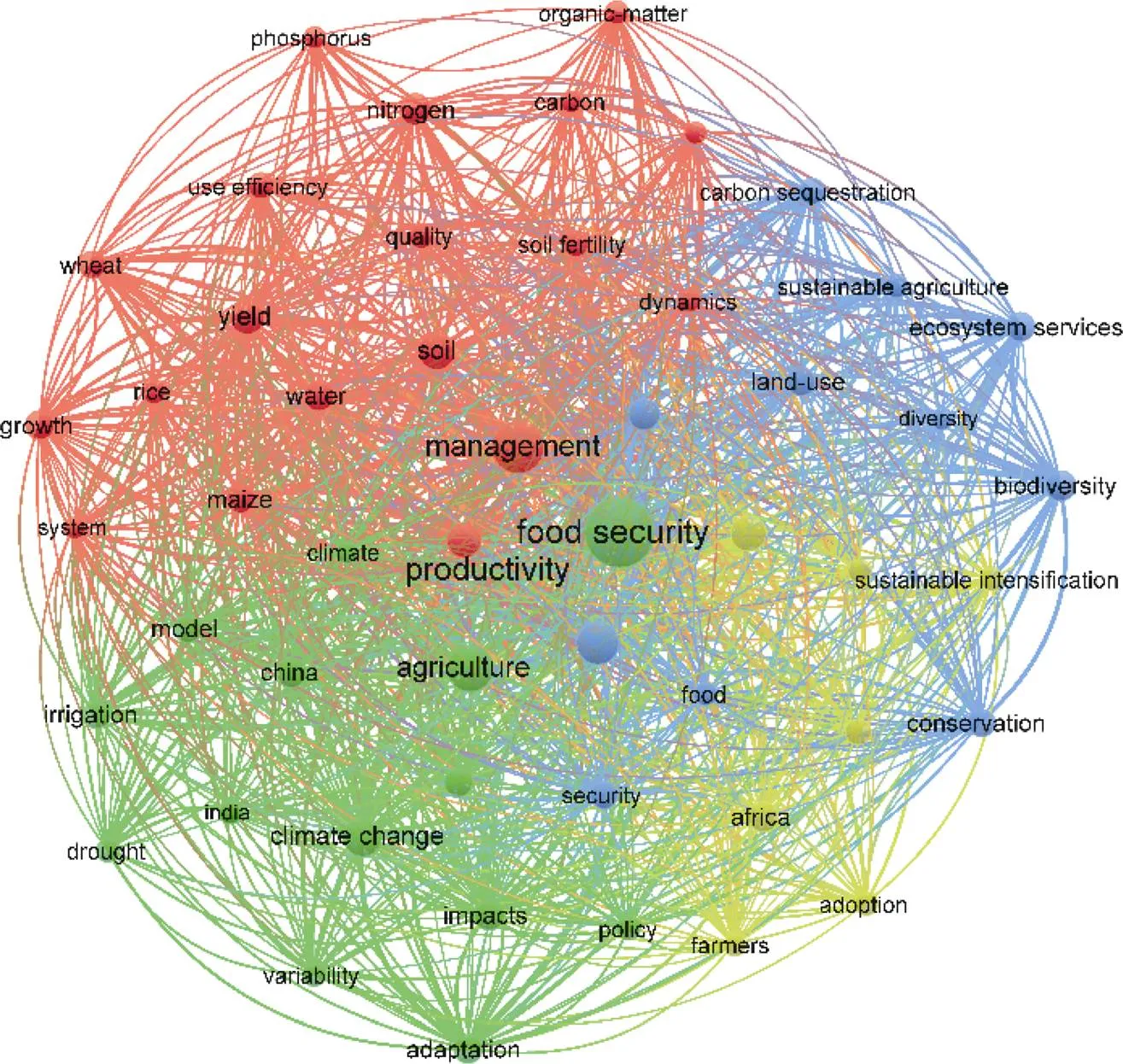
图6 土壤质量与粮食安全关键词共现网络

表1 近5年关键词突现指标
(1)土壤质量管理与食物安全评价。根据土壤、作物的监测调查结果,需要构建土壤质量控制和调节的方法以及优化食物品质和数量安全的评价体系[41-42]。
(2)区域化土壤质量与养分管理。即在选定农业研究区域内进一步进行细分,以针对性的短期、长期农业施肥措施为基础进行精准土壤养分质量管理[43-44]。
(3)污染物在土壤-作物系统的迁移转化规律。土壤污染最大的风险在于污染物在作物中积累并危及人类健康,需明确土壤与作物复杂的交互作用对污染物迁移和积累的影响,以便制定应对措施[4,25,45-46]。
(4)土壤污染阻控与修复技术。强调以降低有机、无机污染物在土壤中的生物有效性为主要目的的修复过程,使污染物尽可能少地进入农产品中,主要包括物理(客土、整地)、化学(钝化、淋洗)修复技术和新兴的生态修复措施[11,47-48]。
(5)土壤生物污染防控。不同于有机、无机污染,外源和土著病原体及其所携带的抗性基因对作物产量影响的监测相对比较困难,外源病原菌一旦进入土壤等自然环境,将极易造成生物污染,其在土壤中的存活时间越长,则对农产品、生态环境和人类健康的潜在风险就越大[49],亟需明确其在土壤中的成活时间、传播途径、演化机制及其影响因子,以制定针对性的防治方案[50]。
(6)土壤区域污染特征与环境风险。过去的研究对土壤质量分区的科学性不足,分类过于粗糙、缺乏统一规范,为土壤污染分级管控带来困难,在“十四五”期间需重点对污染区域进行更科学合理的空间类型与空间单元划分,以便实施进一步的精细化管治措施[51],如对典型污染区域中土壤污染物进行源解析,明确污染物空间分布特征及关键成因,了解污染物持续输入或消减的过程中对环境生态系统的影响和风险[6]。
(7)食物安全与人体健康风险。由于土壤中的有机、无机、生物污染物破坏土壤生态系统,影响作物品质和安全,且会通过食物链进入人体积累,过量时引起健康危害,因此相应的模型评估及管控措施的研究非常有必要,要尽快统一食物安全风险评估标准[52-53]。
2.2 国际研究趋势及理论前沿分析
2.2.1 土壤质量的研究前瞻 在土壤质量研究方面,国际上对土壤质量评价标准体系建立[38]、评价模型方法等的关注度越来越高,同时也开始注重改善土壤质量在农业和环境中的应用,以及在全球范围内开展不同尺度的土壤质量评价工作[54-55]。当前,有机农业与农业固碳在全球气候变化(尤其是全球变暖)中的作用受到广泛关注,且以生物质炭为研究主体的土壤修复与土壤质量关系研究迅速崛起[56]。此外,土壤质量监测及其对土壤修复、全球气候变化的响应也是未来研究的重点。国际上土壤质量方面研究发展的主要趋势包括[42]:(1)发展中国家将在土壤质量研究领域中发挥越来越重要的作用;(2)土壤质量对土壤修复、全球气候变化的响应以及应对措施成为未来的研究热点;(3)不同国家及地区应根据自身特点进行区域土壤质量的监测、评价、修复研究,制定相关法律和政策,保障土壤管理的规范化和可持续化。我国在“十四五”期间也将继续立足生态环境保护的实际需求,重点攻坚土壤污染治理和修复工程,引进国际人才的同时加强本土相关专业人才的培养,致力于打造高水平的创新研究团队,全面建立土壤环境质量监测网络,健全土壤污染防治相关技术标准,推进土壤污染综合防治先行区建设和土壤污染治理与修复技术应用试点项目,加强污染土地安全利用管理以防范和降低食物安全风险,特别是发挥农田土壤在农业空间中的生态功能等[57]。
2.2.2 土壤质量与食物安全的研究前瞻 在土壤质量与食物安全方面,国际研究者在保障农业可持续发展和满足食物需求的基础上,以食物安全性作为研究热点,主要表现为控制食品中污染物的含量,降低人体健康风险[58]。超过土壤承载和自净能力的土壤污染是引起土壤质量下降的重要因素[59],对其污染来源、过程、环境行为、效应及修复机理的研究应当予以深入,并以解决实际生产问题为导向[51,60]。以中国为首的发展中国家,由于人口众多,土地资源紧张,一直受到环境问题和粮食问题的双重困扰。进入21 世纪以来,粮食问题与环境问题之间的矛盾日益突出,更引发了各国对土壤质量的关注,致力于寻求一条可持续发展的道路。在全球化背景下,国际研究的趋势和理论前沿包括:(1)土壤污染源解析[61-62];(2)土壤区域污染特征与人体健康风险;(3)土壤污染过程与机制;(4)土壤污染生态效应;(5)土壤污染修复机理及应用推广。例如,在土壤重金属区域污染特征与源解析的研究中,现有手段仅对部分污染物具有较高的辨识能力与精度[63-64],但借助不断发展的同位素分馏[65]等先进技术,有望更接近真实地表征实际污染土壤中复杂的污染特征,以更精确地判断污染源。同时,在典型重金属与有机污染物的土壤污染过程、效应与机制的研究中,后续工作一方面迫切需要在宏观尺度上着眼于生态系统网络的复杂效应,进一步强调多要素-多界面-多过程的耦合,另一方面也需要在微观尺度下借助分子生物学的迅猛发展,重点关注土壤生态功能(包括作物、土壤微生物和土壤动物)基因水平上的介导机制[66]。此外,在重金属污染土壤的综合修复技术方面,应以植物生长与土壤污染的内在联系为基础突出多种措施的联合应用,特别是对植物生理与分子机制方面的修复效果给与更多的关注[67]。值得注意的是,谈及土壤污染修复,土传病原微生物等造成的生物污染往往容易忽视,未来的重点在于以分子生物学手段建立土壤微生物多样性与土传病害、寄主植物与病原微生物间的定量关系,通过选育抗病作物品种和接种拮抗微生物等环境友好型技术手段实现生物防控[68]。
2.3 学科交叉优先领域
由于土壤质量与食物安全这一分支学科的基础数据涵盖了农业、环境、化学、医学等方面,需要用到信息技术(地理及生物信息)和工程手段来实现研究目标,因此这些学科与本学科经常相互借鉴、交叉和融合,从而促进相关研究的发展。当前条件下,有可能取得重大突破、解决重大污染、生态和灾害问题的优先领域主要为以下两个部分:
2.3.1 学科内部交叉的优先领域 主要是与土壤化学、土壤生物学、土壤肥力与养分循环、土壤污染与修复的交叉,围绕土壤污染过程与土壤微生物的相互作用,探究土壤污染背景下微生物群落结构多样性和功能的演变及生态效应变化,在分子生物学基因水平上揭示重金属、有机和生物污染物对土壤关键功能微生物群落结构的影响及其长期动态演化过程[69]。其次,利用同步辐射、同位素标记及基因组学等先进技术手段,探究微观尺度下重金属(如镉、砷等)、有机污染物(如有机氯农药等)、病原生物(如大肠杆菌、立枯丝核菌、尖孢镰刀菌等)与土壤矿物-有机质-微生物相互作用的多界面过程与机理[70]。在明确植物和微生物系统中响应污染的相关功能基因表达机制基础上,利用转基因技术修饰改造植物或微生物,获得污染土壤的生物高效修复技术[71];同时在土壤污染修复过程中根据土壤微生物的响应特征,尽可能降低原位修复过程对微生物群落结构和生态功能的扰动。
2.3.2 与其他学科交叉的优先领域 这些领域涉及广泛,主要为应用数学、医学、地理信息学等。全球土壤污染问题呈现恶化趋势,进而影响了农作物的品质(产量和污染物含量)以及摄入后的人体健康风险[72]。相比于有机污染物在农产品表面的残留,土壤重金属污染物及病原菌更容易通过作物摄取而通过食物链进入人体,对人体健康造成危害,但目前缺乏对人体健康风险的精准评价手段,现阶段使用的评价模型单一[73],较少考虑人体消化系统(如肠道致病性微生物的毒害)和新陈代谢等复杂生理活动,对人体内污染物的吸收、转运、积累的机制缺乏明确认识。因此,与医学的交叉可获得污染物在人体中传输转化的毒理学规律,同时利用多种模拟预测的数学模型,结合地理信息获取的大数据,理清污染源-环境介质(大气、水、土壤、作物)-人体传输过程中的耦合作用及交互机制,可实现污染源对人体健康风险影响的量化评估。在上述研究的基础上可建立区域污染物的“源-汇-人体”全过程动态风险预测链模型[58],从而实现针对性管控土壤污染物的主要污染源,降低人体健康风险,为预防和治理土壤污染提供新的重要思路和应对机制,促进区域环境与人体健康可持续发展。
3 学科展望
基于上述土壤质量与食物安全分支学科的发展现状、关键需求、理论前沿和重点交叉方向,到2025年有希望和必要形成的引领性研究方向总结如下:
(1)区域土壤污染特征及环境健康风险。包括对重金属、有机、生物等污染物的原位测定技术的革新,区域尺度土壤及农产品污染特征时空变异的表达,主要污染物的溯源及定量解析,土壤-作物系统中污染物迁移规律及空间对应机制的探索,不同污染物的“源-汇-人体”全过程动态风险预测链模型的建立,以及实现对不同人群健康风险的动态预测[74-75]。
(2)土壤重金属及重金属-有机复合污染过程、效应及机制。涵盖土壤-生物微界面过程与生物有效性、吸收动态及毒理学的研究,土壤-作物系统中污染物迁移转化规律的探讨,分子、原子尺度上重金属结合形态、价态变化的表征[76],相关氧化、还原、甲基化过程的微生物学机制揭示以及对应功能基因表达的测定,界面过程中作物和微生物解毒机制的研究,重金属复合污染、重金属-有机复合污染土壤中污染物间交互作用的明确阐述以及土壤微生物群落对污染的响应、适应与反馈调控机制的可视化[77]。
(3)土壤系统典型残留有机污染物的污染风险评价与阻控。包括土壤和农产品中残留的农药等有机污染物及其降解产物全程监控、土壤地下生物系统响应有机污染及不同类型土壤有机污染物自净功能的调控、农药等有机污染物在农田系统残留的暴露与风险,生源要素循环耦合的有机污染物强化消减与阻控修复工程化技术等。
(4)土壤系统新型有机/生物污染与风险防控。主要为农业土壤酞酸酯污染区域特征与风险评估的研究,不同设施种植模式下土壤新型有机物污染特征与源解析的探索[78],残膜分解中微塑料和酞酸酯的土壤累积、生态效应与机理的揭示,不同农业种植模式下生物污染特征与微生物生态系统多样性内在联系、土壤抗性基因库潜在转移风险的探讨,土壤-植物系统中病原体(细菌、真菌、病毒)及携带的抗性基因污染的分布、迁移规律与协同效应评价体系的建立,抗病作物育种-农业投入品无害化-田间土壤质量管理与生态防控模式的集成[79-80],以及设施农业土壤污染源头防控-过程治理-末端监管全链条式高效防控技术与示范的应用和推广[81]。
(5)保障农产品质量的污染土壤安全利用技术原理。涵盖针对复杂污染状况下以降低土壤污染物(特别是重金属、农药)生物有效性和同时提高土壤质量为目标的环境友好型土壤改良剂的研发制备[66],高效富集植物及低积累作物品种的筛选及其生理与分子机制的研究[82],特定复合污染区域特征下土壤-作物-水体系统中立体综合防治技术和协同修复手段的建立(如重金属的钝化、低积累品种筛选、农药的生物降解),以及结合基因工程技术实现适应复杂污染环境、可对多种污染物吸附降解的工程细菌人工培养和安全量产[80,83]。
[ 1 ] Zhao Q G,He J Z,Yan X Y,et al. Progress in significant soil science fields of China over the last three decades:A review[J]. Pedosphere,2011,21(1):1—10.
[ 2 ] Oliver M A. Soil and human health:A review[J]. European Journal of Soil Science,1997,48(4):573—592.
[ 3 ] Liu Y,Wen C,Liu X. China’s food security soiled by contamination[J]. Science,2013,339(6126):1382—1383.
[ 4 ] Zhu H H,Chen C,Xu C,et al. Effects of soil acidification and liming on the phytoavailability of cadmium in paddy soils of central subtropical China[J]. Environmental Pollution,2016,219:99—106.
[ 5 ] Koptsik G N. Modern approaches to remediation of heavy metal polluted soils:A review[J]. Eurasian Soil Science,2014,47(7):707—722.
[ 6 ] Bednářová Z,Kalina J,Hájek O,et al. Spatial distribution and risk assessment of metals in agricultural soils[J]. Geoderma,2016,284:113—121.
[ 7 ] Kaczynski R,Siebielec G,Hanegraaf M C,et al. Modelling soil carbon trends for agriculture development scenarios at regional level[J]. Geoderma,2017,286:104—115.
[ 8 ] Reimann C,Négrel P,Ladenberger A,et al. Comment on “Maps of heavy metals in the soils of the European Union and proposed priority areas for detailed assessment” by Tóth G,Hermann T,Szatmári G,Pásztor L[J]. Science of the Total Environment,2017,578:236—241.
[ 9 ] Mirzaeitalarposhti R,Demyan M S,Rasche F,et al. Mid-infrared spectroscopy to support regional-scale digital soil mapping on selected croplands of South-West Germany[J]. Catena,2017,149:283—293.
[ 10 ] Wang L,Yang D,Li Z,et al. A comprehensive mitigation strategy for heavy metal contamination of farmland around mining areas - Screening of low accumulated cultivars,soil remediation and risk assessment[J]. Environmental Pollution,2018,245:820—828.
[ 11 ] Li Z,Wang L,Meng J,et al. Zeolite-supported nanoscale zero-valent iron:New findings on simultaneous adsorption of Cd(II),Pb(II),and As(III)in aqueous solution and soil[J]. Journal of Hazardous Materials,2018,344:1—11.
[ 12 ] Virto I,Imaz M,Fernández-Ugalde O,et al. Soil degradation and soil quality in western Europe:Current situation and future perspectives[J]. Sustainability,2015,7(1):313—365.
[ 13 ] Eck N J,Waltman L. Software survey:VOSviewer,a computer program for bibliometric mapping[J]. Scientometrics,2010,84(2):523—538.
[ 14 ] Song X F,Chi P J. Comparative study of the data analysis results by vosviewer and citespace[J]. Information Science,2016,34(7):108—112,146. [宋秀芳,迟培娟. Vosviewer与Citespace应用比较研究[J]. 情报科学,2016,34(7):108—112,146.]
[ 15 ] Li B B,Xu M X,Gong C,et al. Hotspots and trends in international soil quality research[J]. Journal of Natural Resources,2017,32(11):1983—1998. [李彬彬,许明祥,巩晨,等. 国际土壤质量研究热点与趋势——基于大数据的Citespace可视化分析[J]. 自然资源学报,2017,32(11):1983—1998.]
[ 16 ] Paleari S. Is the European Union protecting soil? A critical analysis of community environmental policy and law[J]. Land Use Policy,2017,64:163—173.
[ 17 ] Panagos P,Imeson A,Meusburger K,et al. Soil conservation in Europe:Wish or reality?[J]. Land Degradation & Development,2016,27(6):1547—1551.
[ 18 ] Juhos K,Czigány S,Madarász B,et al. Interpretation of soil quality indicators for land suitability assessment – A multivariate approach for Central European arable soils[J]. Ecological Indicators,2019,99:261—272.
[ 19 ] Stone D,Ritz K,Griffiths B G,et al. Selection of biological indicators appropriate for European soil monitoring[J]. Applied Soil Ecology,2016,97:12—22.
[ 20 ] Song X P,Hansen M C,Stehman S V,et al. Global land change from 1982 to 2016[J]. Nature,2018,560(7720):639—643.
[ 21 ] Davidson G R,Phillips-Housley A,Stevens M T. Soil-zone adsorption of atmospheric CO2as a terrestrial carbon sink[J]. Geochimica Et Cosmochimica Acta,2013,106:44—50.
[ 22 ] Wang M,Zhu Y,Cheng L,et al. Review on utilization of biochar for metal-contaminated soil and sediment remediation[J]. Journal of Environmental Sciences,2017,63(1):156—173.
[ 23 ] Duan Q,Lee J,Liu Y,et al. Distribution of heavy metal pollution in surface soil samples in China:A graphical review[J]. Bulletin of Environmental Contamination and Toxicology,2016,97(3):303—309.
[ 24 ] Tóth G,Hermann T,Da Silva M R,et al. Heavy metals in agricultural soils of the European Union with implications for food safety[J]. Environment International,2016,88:299—309.
[ 25 ] He M,Shen H,Li Z,et al. Ten-year regional monitoring of soil-rice grain contamination by heavy metals with implications for target remediation and food safety[J]. Environmental Pollution,2019,244:431—439.
[ 26 ] Fisher M C,Hawkins N J,Sanglard D,et al. Worldwide emergence of resistance to antifungal drugs challenges human health and food security[J]. Science,2018,360(6390):739—742.
[ 27 ] Hwang J,Zimmerman A R,Kim J. Bioconcentration factor-based management of soil pesticide residues:Endosulfan uptake by carrot and potato plants[J]. Science of the Total Environment,2018,627:514—522.
[ 28 ] Yang Q,Li Z,Lu X,et al. A review of soil heavy metal pollution from industrial and agricultural regions in China:Pollution and risk assessment[J]. Science of the Total Environment,2018,642:690—700.
[ 29 ] Zhang Y,Chen J,Wang L,et al. Establishing a health risk assessment for metal speciation in soil-A case study in an industrial area in China[J]. Ecotoxicology and Environmental Safety,2018,166:488—497.
[ 30 ] Szeles A,Horvath E,Vad A,et al. The impact of environmental factors on the protein content and yield of maize grain at different nutrient supply levels[J]. Emirates Journal of Food and Agriculture,2018,30(9):764—777.
[ 31 ] Solgi E,Sheikhzadeh H,Solgi M. Role of irrigation water,inorganic and organic fertilizers in soil and crop contamination by potentially hazardous elements in intensive farming systems:Case study from Moghan agro-industry,Iran[J]. Journal of Geochemical Exploration,2018,185:74—80.
[ 32 ] Miraglia M,Marvin H J P,Kleter G A,et al. Climate change and food safety:An emerging issue with special focus on Europe[J]. Food & Chemical Toxicology,2009,47(5):1009—1021.
[ 33 ] Tirado M C,Clarke R,Jaykus L A,et al. Climate change and food safety:A review[J]. Food Research International,2010,43(7):1745—1765.
[ 34 ] Wang J,Lin Y,Glendinning A,et al. Land-use changes and land policies evolution in China’s urbanization processes[J]. Land Use Policy,2018,75:375—387.
[ 35 ] Xiang C,Wang Y,Liu H. A scientometrics review on nonpoint source pollution research[J]. Ecological Engineering,2017,99:400—408.
[ 36 ] Liu L,Li W,Song W,et al. Remediation techniques for heavy metal-contaminated soils:Principles and applicability[J]. Science of the Total Environment,2018,633:206—219.
[ 37 ] Sun J,Pan L,Tsang D C W,et al. Organic contamination and remediation in the agricultural soils of China:A critical review[J]. Science of the Total Environment,2017,615:724—740.
[ 38 ] Song B,Zeng G,Gong J,et al. Evaluation methods for assessing effectiveness of in situ remediation of soil and sediment contaminated with organic pollutants and heavy metals[J]. Environment International,2017,105:43—55.
[ 39 ] Rickson R J,Deeks L K,Graves A,et al. Input constraints to food production:The impact of soil degradation[J]. Food Security,2015,7(2):351—364.
[ 40 ] Tian X,Qiu J. From challenges to demands and solutions of environmental pollution control in the coming 14th Five-Year Plan period[J]. Chinese Journal of Environmental Management,2019,11(3):46—49. [田欣,秋婕. “十四五”时期污染物总量控制的挑战、需求与应对研究[J]. 中国环境管理,2019,11(3):46—49.]
[ 41 ] Poggio L,Vrščaj B,Hepperle E,et al. Introducing a method of human health risk evaluation for planning and soil quality management of heavy metal-polluted soils—An example from Grugliasco(Italy)[J]. Landscape and Urban Planning,2008,88(2/4):64—72.
[ 42 ] Bai Z,Thomas C,Ruiperez G M,et al. Effects of agricultural management practices on soil quality:A review of long-term experiments for Europe and China[J]. Agriculture Ecosystems & Environment,2018,265:1—7.
[ 43 ] Tang H,Xiao X,Li C,et al. Impact of long-term fertilization practices on the soil aggregation and humic substances under double-cropped rice fields[J]. Environmental Science & Pollution Research,2018,25(4):11034—11044.
[ 44 ] Moreno J L,Bastida F,Ondoño S,et al. Agro-forestry management ofplantations and their impact on soil biological quality:The effects of fertilization and irrigation treatments[J]. Applied Soil Ecology,2017,117/118:46—56.
[ 45 ] Wang M,Chen W,Peng C. Risk assessment of Cd polluted paddy soils in the industrial and township areas in Hunan,southern China[J]. Chemosphere,2016,144:346—351.
[ 46 ] Zhang X,Yang H,Cui Z. Evaluation and analysis of soil migration and distribution characteristics of heavy metals in iron tailings[J]. Journal of Cleaner Production,2018,172:475—480.
[ 47 ] Zhang R,Li Z,Liu X,et al. Immobilization and bioavailability of heavy metals in greenhouse soils amended with rice straw-derived biochar[J]. Ecological Engineering,2017,98:183—188.
[ 48 ] Yoo J,Lee C,Lee J,et al. Simultaneous application of chemical oxidation and extraction processes is effective at remediating soil Co-contaminated with petroleum and heavy metals[J]. Journal of Environmental Management,2017,186:314—319.
[ 49 ] Xu J M. Soil Science[M]. 4th ed. Beijing:China Agriculture Press,2019. [徐建明. 土壤学[M]. 第4版. 北京:中国农业出版社,2019.]
[ 50 ] Bradford S,Morales V,Zhang W,et al. Transport and fate of microbial pathogens in agricultural settings[J]. Critical Reviews in Environmental Science and Technology,2013,43(8):775—893.
[ 51 ] Gao X L,Liao L W,Wu D X,et al. Strategic direction of regional governance upon eco-environment in the 14th Five-Year Plan[J]. Environmental Protection,2019,47:27—32. [高晓路,廖柳文,吴丹贤,等. “十四五”生态环境分区管治的战略方向[J]. 环境保护,2019,47:27—32.]
[ 52 ] Lu Y,Song S,Wang R,et al. Impacts of soil and water pollution on food safety and health risks in China[J]. Environment International,2015,77:5—15.
[ 53 ] Wei J,Cen K. Assessment of human health risk based on characteristics of potential toxic elements (PTEs)contents in foods sold in Beijing,China[J]. Science of the Total Environment,2020,703:134747.
[ 54 ] Mueller L,Schindler U,Shepherd T G,et al. A framework for assessing agricultural soil quality on a global scale[J]. Archives of Agronomy & Soil Science,2012,58:S76—S82.
[ 55 ] Stone D,Costa D,Daniell T J,et al. Using nematode communities to test a European scale soil biological monitoring programme for policy development[J]. Applied Soil Ecology,2016,97:78—85.
[ 56 ] Agegnehu G,Srivastava A K,Bird M I. The role of biochar and biochar-compost in improving soil quality and crop performance:A review[J]. Applied Soil Ecology,2017,119:156—170.
[ 57 ] Liu Z Y,Mao X Q,Jiang H. Directions and strategies of eco-environmental protection during “the 14th Five-Year Plan” period[J]. Environmental Protection,2019,47:37—41. [刘峥延,毛显强,江河. “十四五”时期生态环境保护重点方向和策略[J]. 环境保护,2019,47:37—41.]
[ 58 ] Yang S,Zhao J,Chang S X,et al. Status assessment and probabilistic health risk modeling of metals accumulation in agriculture soils across China:A synthesis[J]. Environment International,2019,128:165—174.
[ 59 ] Plekhanova I O. Self-purification of agrosoddy-podzolic sandy loamy soils fertilized with sewage sludge[J]. Eurasian Soil Science,2017,50(4):491—497.
[ 60 ] Jiang R,Wang M,Chen W,et al. Ecological risk evaluation of combined pollution of herbicide siduron and heavy metals in soils[J]. Science of the Total Environment,2018,626:1047—1056.
[ 61 ] Zhang H,Yao Q,Zhu Y,et al. Review of source identification methodologies for heavy metals in solid waste[J]. Chinese Science Bulletin,2013,58(2):162—168.
[ 62 ] Wang C,Wu S,Zhou S,et al. Characteristics and source identification of polycyclic aromatic hydrocarbons(PAHs)in urban soils:A review[J]. Pedosphere,2017,27(1):17—26.
[ 63 ] Reimann C,de Caritat P. Establishing geochemical background variation and threshold values for 59 elements in Australian surface soil[J]. Science of the Total Environment,2017,578:633—648.
[ 64 ] St. Luce M,Ziadi N,Gagnon B,et al. Visible near infrared reflectance spectroscopy prediction of soil heavy metal concentrations in paper mill biosolid- and liming by-product-amended agricultural soils[J]. Geoderma,2017,288:23—36.
[ 65 ] Wang W,Song X,Ma Y. Identification of nitrate source using isotopic and geochemical data in the lower reaches of the Yellow River irrigation district(China)[J]. Environmental Earth Sciences,2016,75(11):936.
[ 66 ] Li Z,Wang L,Wu J,et al. Zeolite-supported nanoscale zero-valent iron for immobilization of cadmium,lead,and arsenic in farmland soils:Encapsulation mechanisms and indigenous microbial responses[J]. Environmental Pollution,2020,260:114098.
[ 67 ] Jiang J,Liu H,Li Q,et al. Combined remediation of Cd–phenanthrene co-contaminated soil byandFQ1 and the antioxidant responses in[J]. Ecotoxicology & Environmental Safety,2015,120:386—393.
[ 68 ] Cai Z C,Huang X Q. Soil-borne pathogens should not be ignored by soil science[J]. Acta Pedologica Sinica,2016,53(2):305—310. [蔡祖聪,黄新琦. 土壤学不应忽视对作物土传病原微生物的研究[J]. 土壤学报,2016,53(2):305—310.]
[ 69 ] Xie Y,Fan J,Zhu W,et al. Effect of heavy metals pollution on soil microbial diversity and Bermudagrass genetic variation[J]. Frontiers in Plant Science,2016,7(245):1—12.
[ 70 ] Xia S,Song Z,Jeyakumar P,et al. A critical review on bioremediation technologies for Cr(VI)-contaminated soils and wastewater[J]. Critical Reviews in Environmental Science and Technology,2019,49(12):1027—1078.
[ 71 ] Manoj S,Karthik C,Kadirvelu K,et al. Understanding the molecular mechanisms for the enhanced phytoremediation of heavy metals through plant growth promoting rhizobacteria:A review[J]. Journal of Environmental Management,2020,254:109779.
[ 72 ] Rehman Z U,Khan S,Brusseau M L,et al. Lead and cadmium contamination and exposure risk assessment via consumption of vegetables grown in agricultural soils of five-selected regions of Pakistan[J]. Chemosphere,2017,168:1589—1596.
[ 73 ] Liu X,Zhong L,Meng J,et al. A multi-medium chain modeling approach to estimate the cumulative effects of cadmium pollution on human health[J]. Environmental Pollution,2018,239:308—317.
[ 74 ] Wang P,Chen H,Kopittke P,et al. Cadmium contamination in agricultural soils of China and the impact on food safety[J]. Environmental Pollution,2019,249:1038—1048.
[ 75 ] Yang S,He M,Zhi Y,et al. An integrated analysis on source-exposure risk of heavy metals in agricultural soils near intense electronic waste recycling activities[J]. Environment International,2019,133(B):105239.
[ 76 ] Kopittke P M,Wang P,Lombi E,et al. Synchrotron-based X-ray approaches for examining toxic trace metal(loid)s in soil–plant systems[J]. Journal of Environmental Quality,2017,46(6):1175—1189.
[ 77 ] Xiao S,Zhang Q,Chen X,et al. Speciation distribution of heavy metals in uranium mining impacted soils and impact on bacterial community revealed by high-throughput sequencing[J]. Frontiers in Microbiology,2019,10:1867.
[ 78 ] Zhang Y,Wang P,Wang L,et al. The influence of facility agriculture production on phthalate esters distribution in black soils of northeast China[J]. Science of the Total Environment,2015,506:118—125.
[ 79 ] Salanoubat M,Genin S,Artiguenave F,et al. Genome sequence of the plant pathogen[J]. Nature,2002,415(6871):497—502.
[ 80 ] Zhao F J,Xie W Y,Wang P. Soil and human health[J]. Acta Pedologica Sinica,2020,57(1):1—11. [赵方杰,谢婉滢,汪鹏. 土壤与人体健康[J]. 土壤学报,2020,57(1):1—11.]
[ 81 ] Ma Y,Liu Z,Xi B,et al. Characteristics of groundwater pollution in a vegetable cultivation area of typical facility agriculture in a developed city[J]. Ecological Indicators,2019,105:709—716.
[ 82 ] Guo H,Hong C,Xiao M,et al. Real-time kinetics of cadmium transport and transcriptomic analysis in low cadmium accumulator[J]. Planta,2016,244(6):1289—1302.
[ 83 ] Liu L,Bilal M,Duan X,et al. Mitigation of environmental pollution by genetically engineered bacteria - Current challenges and future perspectives.[J]. Science of the Total Environment,2019,667:444—454.
Frontier Trends and Development Strategies of Soil Quality and Food Safety in the 14th Five-Year Plan
XU Jianming1, 2†, LIU Xingmei1, 2
(1. Institute of Soil and Water Resources and Environmental Science, Zhejiang University, Hangzhou 310058, China; 2. Zhejiang Provincial Key Laboratory of Agricultural Resources and Environment, Zhejiang University, Hangzhou 310058, China)
The comprehensive evaluation and improvement of soil quality are closely linked with food security and human health. As an important component of the development strategy of soil science during the 14th Five-Year Plan, the subdiscipline about the soil quality and food security is making contribution to govern and improve the quality of cultivated soil, which will cope with the food security crisis. The results of bibliometric analysis show that although China has started late in the research of this subdiscipline compared with the developed countries, it is accelerating upward and even has the tendency to surpass all of the other countries in recent years. With the erupting of the climate and environmental pollution issues, the international research hotpots of this subdiscipline are mainly focused on the environmental monitoring, soil utilization, fertilization management, remediation of pollution (heavy metal (loid), antibiotic, organic pesticide, and pathogenic microorganism) and sustainable development. Meanwhile, this subdiscipline takes the soil quality, soil pollution, and food security as the key research directions. Combined with the fields of geomatics, environmental science, applied mathematics, and medicine to form new prior interdisciplines, this subdiscipline can utilize their advanced theories and techniques of isotope tracer, biogeochemical cycling, molecular biology, and health risk model to solve some key scientific problems in the soil quality monitoring under regional scale, quality management of soil nutrients, human health risk assessment, migration and transformation of pollutants in soil-crop systems, and immobilization and remediation of soil pollution in the future.
Soil quality; Food security; Soil pollution; Bibliometric analysis; Future demand
S15
A
10.11766/trxb202003300110
徐建明,刘杏梅. “十四五”土壤质量与食物安全前沿趋势与发展战略[J]. 土壤学报,2020,57(5):1143–1154.
XU Jianming,LIU Xingmei. Frontier Trends and Development Strategies of Soil Quality and Food Safety in the 14th Five-Year Plan [J]. Acta Pedologica Sinica,2020,57(5):1143–1154.
* 国家自然科学基金创新研究群体项目(41721001)和重大项目(41991334)资助 Supported by the National Natural Science Foundation of China Innovation Research Group Project(No. 41721001)and the Major Program of the National Natural Science Foundation of China(No. 41991334)
,E-mail:jmxu@zju.edu.cn
徐建明(1965—),男,浙江桐乡人,博士,教授,主要从事土壤化学与生物化学、土壤污染控制与修复、产地环境质量与农产品安全等领域的研究。
2020–03–30;
2020–05–03;
优先数字出版日期(www.cnki.net):2020–05–26
(责任编辑:陈德明)
